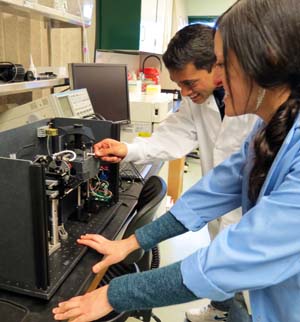VIIBRE - Facilities
VIIBRE is located on the first and eighth floors of Building 6 of the Stevenson Center for the Natural Sciences and Engineering, where it occupies a total of ~9,000 square feet immediately adjacent to the Departments of Chemistry, Physics, and Biomedical Engineering and the Vanderbilt Medical Center.
VIIBRE Laboratories
The Cardiac Panoramic Imaging Laboratory and the SQUID Imaging Laboratory are dedicated to the development and application of advanced optical and magnetic instrumentation for biophysical measurements, particularly on cardiac tissue. The Cardiac Panoramic Imaging Laboratory is equipped for electrical, magnetic, thermal, and biochemical imaging of cardiac tissue and cellular preparations. It has two dedicated fluorescence imaging suites with physiological support systems, lasers, and high speed cameras. One of the laboratories contains animal and chemical preparation areas. The dedicated cardiac cell culture facility is being constructed in an adjoining room for creating tissue-engineered rat and human cardiac tissue constructs.
The SQUID Imaging Laboratory is a state-of-the-art facility that has designed, built, and demonstrated a new class of low-temperature superconductivity (LTS), ultrahigh resolution, scanning Superconducting Quantum Interference Device (SQUID) microscopes. SQUID microscope and human measurements are conducted in a Vacuumschmelze 15 ft × 12 ft × 9 ft magnetically shielded room that was installed in 1993 for studies of biomagnetic signals from humans and for other measurements requiring a low field environment.
The Cellular Instrumentation and Control Laboratory is dedicated to high-bandwidth (i.e., rapid temporal response) studies of the dynamics of cellular signaling and metabolism. A particular focus is paid towards cell-based biosensors, and using soft-lithographic MEMS fabrication techniques to create silicone-based elastomeric Micro- and Nanophysiometers that measure simultaneously, from a small population of cultured cells in microliter to sub-nanoliter cell-culture chambers, oxygen consumption, extracellular pH, glucose consumption, lactate production, amino acid consumption and production, and release of specific small molecules, intracellular quantities such as oxidation/reduction potential, transmembrane potential, calcium concentration, and the expression of selected chemokines. Active pumps and feedback controls are being developed to maintain long-term cell health in the highly restricted nanoliter culture volumes. The VIIBRE cellular instruments are being created using state-of-the-art multichannel potentiostats, inverted microscopes, computer-controlled micropumps, and high-speed CCD and photodiode fluorescence imaging systems.

|

|
General VIIBRE Laboratories include a biochemistry laboratory, a conference room, a cold-room, a darkroom, electronics and machine shops, and a laboratory services room. In addition to its own shops, staffed by full-time technicians and engineers, VIIBRE is a regular user of the Natural Science Division Machine Shop, also in Building 6, which is staffed by three full-time instrument makers.
Other resources established by VIIBRE include various core technologies that are directly relevant to cell biology, cancer, biodefense and infectious disease detection. These include Cytosensor microphysiometers with added capabilities for simultaneous measurement of glucose, lactate, and oxygen to create multianalyte microphysiometers (MAMP); microfabrication facilities; nanophysiometers for measurements on single cells; gradient migration chambers; beds-of-nails for traction force microscopy; high porosity nanofilters for cellular perfusion and other applications; nanobioreactors for perfusing small populations of cells in multiple cell traps; thick tissue bioreactors for tissue explants; devices to allow measurements of insulin and glucose signaling in a single pancreatic islet; and cell traps and filters to study the behavior of bacteria-protozoa colonies.
